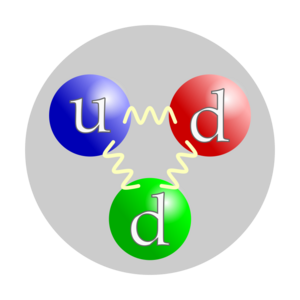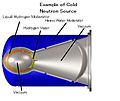Neutron facts for kids
Neutrons are tiny particles found inside every atom. They live in the center of the atom, called the nucleus, along with protons. Unlike protons, which have a positive electric charge, or electrons, which have a negative charge, neutrons have no charge at all – they are neutral! This is how they got their name. Neutrons help hold the nucleus together with a very strong force called the strong force.
Contents
How Neutrons Were Discovered
Scientists first thought about neutrons because something was missing from their understanding of atoms. A famous scientist named Ernest Rutherford suggested they might exist. Later, in 1932, another scientist named James Chadwick proved they were real. He did this by shooting atoms at a thin piece of beryllium. Particles came out that had no charge, and he called them 'neutrons'. This discovery helped scientists create a more complete picture of what atoms look like.
What Neutrons Are Made Of
Neutrons are incredibly small, but they are not the smallest particles. They are part of a group of particles called hadrons. Just like protons, neutrons are made up of even smaller particles called quarks. A neutron has two down quarks and one up quark. An up quark has a charge of +2/3, and each down quark has a charge of -1/3. When you add these charges together (+2/3 - 1/3 - 1/3), they cancel out, which is why a neutron has a neutral (zero) charge. These quarks are held together by other tiny particles called gluons.
Neutrons are also very light, but they are a little heavier than protons. They are about 1,839 times heavier than electrons!
Neutrons and Isotopes
Almost all atoms have neutrons, protons, and electrons. The only exception is a very common type of Hydrogen atom, called Hydrogen-1, which usually has just one proton and no neutrons.
Atoms of the same element always have the same number of protons. However, they can have different numbers of neutrons. When atoms of the same element have different numbers of neutrons, they are called isotopes. For example, all carbon atoms have 6 protons, but some might have 6 neutrons (Carbon-12), and others might have 8 neutrons (Carbon-14).
The number of neutrons in an atom doesn't change its chemical behavior much. But it does affect how stable the atom is. Some isotopes are very stable and last a long time, while others are unstable and break down quickly. This breaking down is called radioactivity, and it's measured by something called a half-life. An unstable isotope has a short half-life, meaning half of it will decay into lighter elements in a short amount of time.
Neutrons in Atomic Reactions
Neutrons are super important in nuclear chain reactions. These reactions are used to create nuclear power in power plants, and they are also the basis for nuclear weapons. Because neutrons have no charge, they can easily hit the nucleus of other atoms and cause them to split, releasing a lot of energy and more neutrons, which then hit other atoms, creating a chain reaction.
Related pages
Images for kids
See also
 In Spanish: Neutrón para niños
In Spanish: Neutrón para niños




